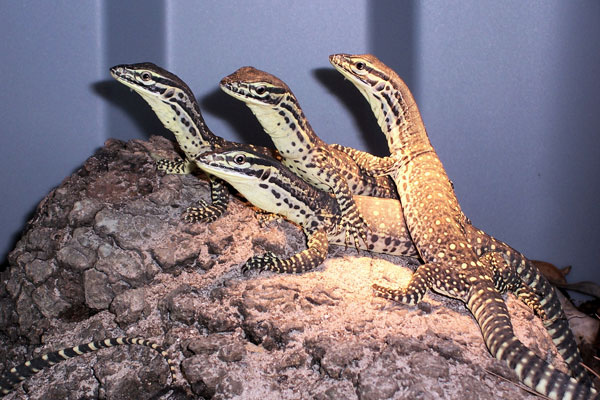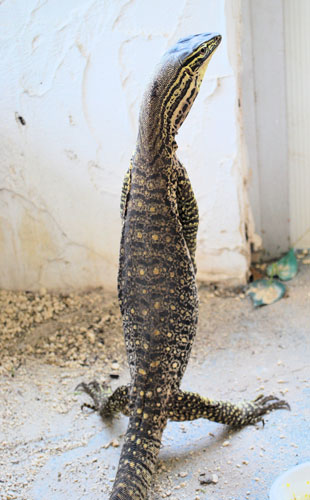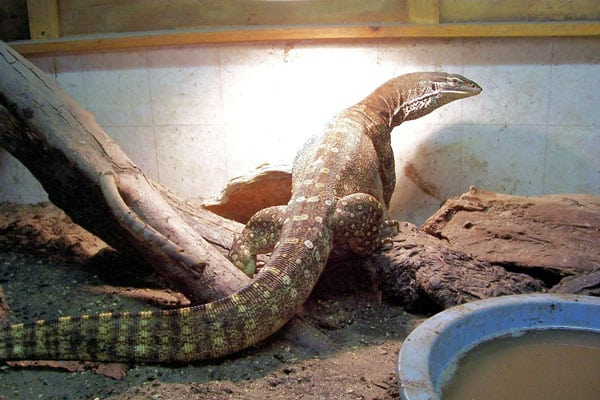Care sheet for the Argus monitor (Varanus panoptes horni).
Argus Monitor (Varanus panoptes horni)
The Argus monitor is endemic to the southern coastal, grass, riparian and woodland habitats of the island of New Guinea, both Indonesian and New Guinea countries, and some islands of the Torres Straights. It is adaptive to a wide range of habitat types.
The subspecies horni is replaced by V. p. panoptes in Australia, ranging from the Cape York peninsula of Queensland and going west across the top end of the continent into Western Australia province. There is a third subspecies, V. p. rubidus, that is found in Western Australia province only. It is an attractive lizard with a more reddish coloration and high-contrast spotting on the dorsum and tail. Neither of these Australian subspecies are found in the international pet trade due to strict wildlife protection laws of Australia.
Argus Monitor Availability
All three subspecies are CITES-listed Appendix II animals, and the Argus monitor is the only one found in the U.S. pet trade. It is sometimes imported from Indonesia, though a very large captive-born-and-bred population typically supplies the U.S. pet trade market. The Argus monitor, by monitor standards, is fairly widely bred in captivity.
Argus Monitor Size
Newly born neonates are typically 10 to 12 inches in length and grow very quickly. Adults are sexually dimorphic, with males often reaching a total length of 4½ to 5 feet. Females typically remain about 3½ feet maximum total length.
As with most monitor species, male Argus monitors are more robustly built than female Argus monitors, with more powerful, bulky front legs. People often refer to male Argus monitors as having “Popeye” arms versus the more daintily built females.
Argus Monitor Lifespan
With proper care, an Argus monitor can live 15 to 20 years in captivity.

Baby Argus monitors are more brightly colored and patterned than the adults. Photo by Justin Burokas.
Argus Monitor Caging
Because an adult male Argus monitor can reach up to 5 feet in total length, caging for adults usually involves construction of a custom vivarium that is no smaller than 8 feet in length by 4 feet in width. Height can vary, but I strongly recommend at least a 5-foot-tall enclosure, with 2 feet of substrate in the bottom. This would be the minimum enclosure size for an adult male Argus monitor.
I typically construct my Argus monitor cages out of plywood and wooden support beams. Alternative caging could be a metal cattle watering trough with a wooden box constructed over the trough. Onto the wooden top portion you could insert a pre-framed window or custom glass sliders for access to the inside of the enclosure. This would result in a very functional and pleasant-looking vivarium for your Argus monitor.
Argus monitors are very adept at digging tunnels and refugia within the cage substrate. I offer several large logs, hollow cork tubes and stones firmly affixed to the cage bottom or walls to prevent collapse and possible harm to a digging lizard (and the Argus monitor is a natural-born digger).
Argus Monitor Lighting and Temperature
An Argus monitor cage should provide a temperature gradient with an air temperature of 75 degrees Fahrenheit on the cool end, going up to a warm side of 100 degrees. Also provide a basking temperature of about 115 degrees directly beneath a basking light, as indicated via a thermometer. If you’re using a non-contact infrared temp gun to measure temperatures, strive for a reading of 125 to 135 degrees. With multiple enclosures to check, I prefer to use a temp gun. I can get accurate readings at several locations within a cage in seconds, and I save the cost of having to purchase a lot of thermometers.
Because of the large size of an adult Argus monitor, I recommend creating a basking area using multiple lamps and not just a single lamp. If a lizard is 4 feet long or more (with a 2-foot snout-to-vent length), it might burn its skin if it remains for long periods beneath a heat source comprised of a single spotlight with a narrowly focused cone of light and heat. Two or three bulbs of a lesser wattage positioned close together above the basking area will provide coverage for the lizard’s entire body and could help prevent accidental burns that may otherwise occur using a smaller, more intensely focused heat source.
The use of UV-producing lights has been debated in regard to keeping monitor lizards. Certainly, monitors have been raised and reproduced many times using simple incandescent lighting and by feeding a proper diet of whole-prey items, such as rodents and insects with supplements. Still, knowing that certain lizard species (such as green iguanas) metabolize vitamin D3 to its active form using UVB lighting, and that the reptile pineal organ is stimulated by UVA lighting, I recommend providing both types of UV for captive monitors that do not have access to pure, unfiltered sunlight.
Argus Monitor Substrate and Accessories
For Argus monitor substrate I have used everything from cypress mulch chips, pure sand and topsoil to plantation soils and coconut husk/coir byproducts. I have even offered my monitors a bedding of deep leaves found outdoors.
My current personal preference for my Argus monitors is to utilize a substrate mix containing “diggable” sandy soil found outside, mixed with 25 to 50 percent coconut coir. The coir retains humidity better than simple sandy soils and allows a very nice, non-collapsing burrow system for these somewhat fossorial lizards. The coir and sand will not stain a lizard’s skin, either, so the animals look nice in their cages under high-quality lighting. If you choose to dig up your own soil, be certain it is from an area that has not been sprayed with fertilizers or pesticides.
Commercial potting soils can contain caustic additives, such as nitrogen and time-released fertilizer spheres designed to help plants grow, and they can be mucky and stain the lizards’ skin. They can also irritate a lizard’s eyes, mouth, throat and lungs in a confined space.
Argus Monitor Diet and Feeding
Argus monitors learn very quickly that the keeper equals a meal. They are intelligent animals with a relatively high metabolism for a reptile, and in my experience they “go for it” with much more enthusiasm than most other more monitors. So be careful at feeding time.
Typical dietary items are insects such as crickets or super worms, pre-killed and thawed mice of the proper size, day-old chicks, fish, crayfish and most any other whole-animal prey items. I am a firm believer that whole prey items are a superior diet to feeding strips of meat, eggs, and organ meat sold at grocery stores. These “meat” items are only a portion of the dietary needs of a carnivorous lizard and are very high in phosphorus versus calcium. Obviously, a few boiled eggs or strips of lean meat will not harm an Argus monitor nutritionally, but the bulk of the Argus monitor diet should be made up of whole prey items and insects, and insects should be dusted several times per week with a good-quality mineral supplement used as directed.
Argus Monitor Water and Humidity
A large tub or pool in which to swim and soak will be greatly appreciated by an Argus monitor. You will need to change the water frequently as Argus monitors often defecate while in the water, though this actually makes cage cleaning maintenance easier and the cage more hygienic.
The Argus monitor can tolerate a range of humidity levels, although a more humid and moist environment seems to make them happier and promotes easier shedding. It is inappropriate to house an Argus monitor in a fish tank with a screen lid and a hot light source over the screen. This creates a desiccating effect on the entire enclosure and you will end up wetting down and misting the cage almost daily. Affixing a solid plexiglass lid with only a few air holes on the cool side, or tinfoil and duct-taping a portion of the screen over the top, can retain valuable heat and humidity within the vivarium without having to add so much water or using higher-wattage lighting and heating bulbs.
A relative humidity of 70 to 80 percent mid-enclosure is typically acceptable. I keep the substrate moist a few inches down, but fairly dry on the surface.

This Argus monitor is “tripodding,” a defensive stance. If you see an Argus monitor in this position, there’s a good chance it’s irritated.
Argus Monitor Handling and Temperament
The Argus monitor is an active and hissy monitor species. It is a bold and curious animal to view in the vivarium, but an Argus monitor does not appreciate being picked up and held, and it will not usually come to accept this even with repeated handling.
Defensive Argus monitors will often stand on their hind legs and tails (known as “tripodding”) and inflate the throat to appear larger and more formidable. They will also emit a long, slow, deep hissing noise to dissuade you from approaching them. This lets you know that they feel threatened. While Argus monitors typically do not bite out of fear (as opposed to an accidental bite due to being overeager at feeding time), be cautious. I have noted that an adult male will usually tripod as a first defense measure. If I keep advancing toward the animal, it will lunge at me in an attempt to spook me away.
Some Argus monitors, typically old males, will relax and allow some handling and interaction, but to say they all will calm down with daily handling would be false. As mentioned, the Argus monitor, like most monitor lizards, is not very tolerant of being subdued and held. I always tell prospective owners that its best to consider the Argus monitor a display animal, and not one that should be handled.
Justin “Krusty” Burokas has successfully kept and bred various lizards for more than 20 years, including the Argus monitor since 2003.


